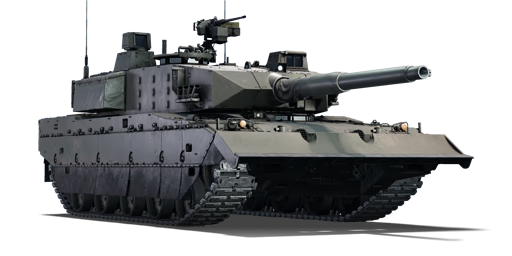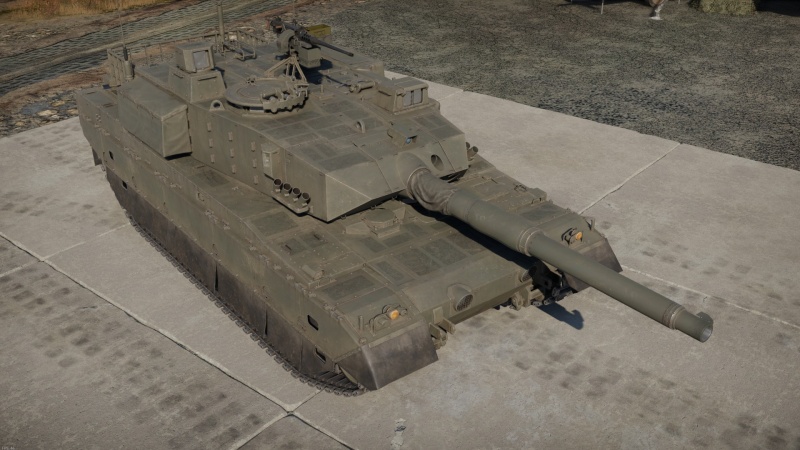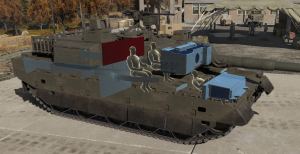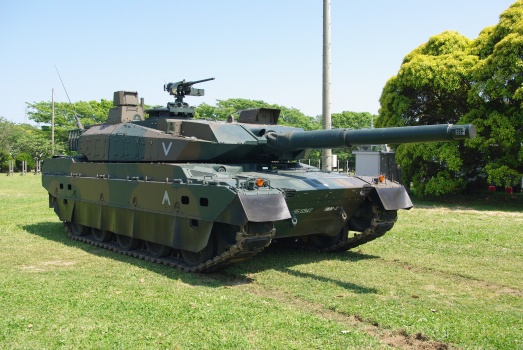Difference between revisions of "TKX (P)"
(→See also) |
(→General info) (Tag: Visual edit) |
||
| Line 18: | Line 18: | ||
=== Survivability and armour === | === Survivability and armour === | ||
{{Specs-Tank-Armour}} | {{Specs-Tank-Armour}} | ||
| − | <!-- ''Describe armour protection. Note the most well protected and key weak areas. Appreciate the layout of modules as well as the number and location of crew members. Is the level of armour protection sufficient, is the placement of modules helpful for survival in combat? If necessary use a visual template to indicate the most secure and weak zones of the armour.'' --> | + | <!-- ''Describe armour protection. Note the most well protected and key weak areas. Appreciate the layout of modules as well as the number and location of crew members. Is the level of armour protection sufficient, is the placement of modules helpful for survival in combat? If necessary use a visual template to indicate the most secure and weak zones of the armour.'' -->The armor of the TKX (P) is not the best, but it can stop rounds if they hit the wrong areas. The turret cheeks are by far the most armored part of the TKX (P), featuring up to 600 mm of armor made from various materials. However, if luck is not on one’s side, some tanks may be able to shoot through the turret cheeks and eliminate the commander. |
| − | + | [[File:TKX (P) Crew .png|thumb|Here is the crew positions and armor]] | |
| + | The turret has composite armor only in the front, so a well-placed shot to the side can result in the loss of both the commander and the gunner. Additionally, the hull of the TKX (P) lacks sufficient armor, with composite armor only present at the very front of the tank, totaling about 500 mm. An experienced player can exploit this weakness by targeting the lower front plate, which can take out the driver. | ||
'''Armour type:''' <!-- The types of armour present on the vehicle and their general locations --> | '''Armour type:''' <!-- The types of armour present on the vehicle and their general locations --> | ||
| Line 178: | Line 179: | ||
;Related Development | ;Related Development | ||
| + | |||
* [[Type 90 (Family)]] - <small>(predecessor)</small> | * [[Type 90 (Family)]] - <small>(predecessor)</small> | ||
* [[Type 10 (Family)]] | * [[Type 10 (Family)]] | ||
Latest revision as of 12:32, 26 October 2024
| This page is about the Japanese medium tank TKX (P). For other versions, see Type 10 (Family). |
Contents
Description
The TKX (P) is an earlier iteration of the TKX, serving as a prototype of the Type 10 MBT. As the Japanese Self-Defense Forces (JSDF) pursue ongoing advancements in tank technology, they've prioritized key enhancements over the Type 90, These upgrades include a focus on reduced weight without compromising armour effectiveness, heightened integration of C4I capabilities, and the introduction of modular armour configurations. These modular slots allow for the seamless interchangeability of armour kits, ranging from lightweight to standard and even specialized war kits. The TKX (P) is the foundational platform for the Type 10 series, presenting a "barebones" configuration ready to accommodate various modular armour configurations tailored to specific operational requirements.
It was introduced in Update "Sons of Attila". The TKX (P) comes as a supplement to the Type 90 with the improved Gen 3 thermals as opposed to Gen 1 and a smaller mantlet at the cost of turret side protection and overall mobility. As an early prototype of the Type 10, it doesn't come with its distinct Type 10 APDSFS shell. This leaves the TKX (P) as a hybrid of the Type 16 in overall manoeuvre paths and spotting visibility with the firepower of a Type 90.
General info
Survivability and armour
The armor of the TKX (P) is not the best, but it can stop rounds if they hit the wrong areas. The turret cheeks are by far the most armored part of the TKX (P), featuring up to 600 mm of armor made from various materials. However, if luck is not on one’s side, some tanks may be able to shoot through the turret cheeks and eliminate the commander.
The turret has composite armor only in the front, so a well-placed shot to the side can result in the loss of both the commander and the gunner. Additionally, the hull of the TKX (P) lacks sufficient armor, with composite armor only present at the very front of the tank, totaling about 500 mm. An experienced player can exploit this weakness by targeting the lower front plate, which can take out the driver.
Armour type:
| Armour | Front (Slope angle) | Sides | Rear | Roof |
|---|---|---|---|---|
| Hull | ___ mm | ___ mm Top ___ mm Bottom |
___ mm | ___ - ___ mm |
| Turret | ___ - ___ mm Turret front ___ mm Gun mantlet |
___ - ___ mm | ___ - ___ mm | ___ - ___ mm |
| Cupola | ___ mm | ___ mm | ___ mm | ___ mm |
Notes:
Mobility
| Game Mode | Max Speed (km/h) | Weight (tons) | Engine power (horsepower) | Power-to-weight ratio (hp/ton) | |||
|---|---|---|---|---|---|---|---|
| Forward | Reverse | Stock | Upgraded | Stock | Upgraded | ||
| Arcade | 78 | 78 | 44.4 | 1,626 | 2,290 | 36.62 | 51.58 |
| Realistic | 71 | 71 | 1,061 | 1,200 | 23.9 | 27.03 | |
Modifications and economy
Armaments
Main armament
| 120 mm TKG | Turret rotation speed (°/s) | Reloading rate (seconds) | ||||||||
|---|---|---|---|---|---|---|---|---|---|---|
| Mode | Capacity | Vertical | Horizontal | Stabilizer | Stock | Upgraded | Full | Expert | Aced | Autoloader |
| Arcade | 35 | -7°/+10° | ±180° | Two-plane | 28.6 | 39.5 | 48.0 | 53.1 | 56.5 | 4.00 |
| Realistic | 17.9 | 21.0 | 25.5 | 28.2 | 30.0 | |||||
Ammunition
| Penetration statistics | |||||||
|---|---|---|---|---|---|---|---|
| Ammunition | Type of warhead |
Penetration @ 0° Angle of Attack (mm) | |||||
| 10 m | 100 m | 500 m | 1,000 m | 1,500 m | 2,000 m | ||
| JM12A1 | HEATFS | 480 | 480 | 480 | 480 | 480 | 480 |
| JM33 | APFSDS | 481 | 478 | 470 | 461 | 450 | 440 |
| Shell details | ||||||||||||
|---|---|---|---|---|---|---|---|---|---|---|---|---|
| Ammunition | Type of warhead |
Velocity (m/s) |
Projectile mass (kg) |
Fuse delay (m) |
Fuse sensitivity (mm) |
Explosive mass (TNT equivalent) (kg) |
Ricochet | |||||
| 0% | 50% | 100% | ||||||||||
| JM12A1 | HEATFS | 1,140 | 13.5 | 0.05 | 0.1 | 2.15 | 65° | 72° | 77° | |||
| JM33 | APFSDS | 1,640 | 4.3 | - | - | - | 78° | 80° | 81° | |||
Ammo racks
| Full ammo |
1st rack empty |
2nd rack empty |
3rd rack empty |
4th rack empty |
5th rack empty |
6th rack empty |
Visual discrepancy |
|---|---|---|---|---|---|---|---|
| 35 | __ (+__) | __ (+__) | __ (+__) | __ (+__) | __ (+__) | __ (+__) | __ |
Machine guns
| 12.7 mm M2HB | ||||
|---|---|---|---|---|
| Mount | Capacity (Belt) | Fire rate | Vertical | Horizontal |
| Pintle | 1,000 (200) | 575 | -8°/+60° | ±180° |
| 7.62 mm Type 74 | ||||
|---|---|---|---|---|
| Mount | Capacity (Belt) | Fire rate | Vertical | Horizontal |
| Coaxial | 3,000 (250) | 700 | - | - |
Usage in battles
The TKX (P) is a prototype of the Type 10 with the modular turret side armour not equipped and only able to fire JM33 as it's too early in development to fire the new Type 10 APDFS shell. With these missing upgrades, the TKX (P) bolsters the Type 90 line-up as a sidegrade trading these features:
- + Stronger frontal protection
- + Better thermals (Gen 3 instead of 1)
- - Relatively slower, especially in acceleration
- - Smaller autoloader rack (14 instead of 18)
The TKX is a highly mobile and fast-firing MBT that excels in flanking and sniping roles. However, its armour is not reliable and it is vulnerable to enemy fire, so it requires constant situational awareness and effective use of its hydropneumatic suspension, LWS, Laser Rangefinder and smoke grenades. The Type 10 should not engage in frontal assaults or close combat, but rather support allied MBTs from a safe distance and exploit its mobility and firepower to deal damage and relocate as needed. Getting early warnings of potential incoming fire thanks to its LWS, providing enough time and knowledge to retreat or dodge incoming shells.
Pros and cons
Pros:
- Autoloaded 120 mm cannon, 4-second reload unaffected by crew or fire
- Has access to 3rd generation thermal sights for the gunner and commander
- Quite mobile, high power-to-weight ratio and high reverse speed
- Fitted with hydropneumatic suspension, although this can only be operated when stationary
- Can lower the tank significantly, allowing you to hide behind relatively low hills and ridges
- Primary ammunition storage protected within blow-out containment in the rear of the turret
- Relatively small profile
Cons:
- Only three crew, a well-placed shot can easily cause a full crew knock-out
- Can only carry 15 rounds before additional ammo is stored in the unsafe hull racks
- Hydropneumatic suspension ceases to work when the engine is hit
- Relatively poor gun depression, unless the suspension is used
- Armour is very spread out in the front with the only well-defended places being the upper front plate, turret cheeks, and breech
- Lacks turret side armour
- While fast in top speed, this tank is a bit slow to accelerate
- Slow elevation/depression speed for the main gun
- Slower turret traverse than most other MBTs
History
Challenges of New Millennium
In the mid-1990s, after the introduction of the previous TKX-1, Type 90 MBT, the Ministry of Defense soon realised that, despite its superior FCS even for NATO standards, further upgrading the Type 90 would be impractical (for the time being) due to its already heavy weight in Japan's standards; while the previous Type 61 Medium Tank had no chance when facing even the earliest MBTs and Type 74 MBT was too costly to be upgraded. The possible rivals of Japan, like Mainland China and the Russia Federation had already developed their new MBTs (PLAGF ZTZ96 and ZTZ99/Russian T-90A); in view of maintaining a team of tank designers as well as a part of national defense, JGSDF passed a new plan for a next-generation MBT with redundancy for further upgrades (modularity), thus inherited the project name: TKX-2.
From Kyumaru to Hitomaru
The TKX-2 project aimed for the light weight of a Type 74 (at 40 tons, loaded) while being smaller than Type 90, equipping a domestic 120 mm smoothbore gun with latest C4ISR system, modular composite armour, and new engines paired with HMT transmission. TKX-2 was led by the TRDI with help from Mitsubishi Heavy Industries. The new smoothbore gun and its new APFSDS were developed by Nippon Steel Corporation and Daikin Industries respectively. These designs were tested on a Tank Test Bed (TTB) developed from the 6th prototype of Type 90 and was first shown in a booklet in the early 2000s; the result of TTB proved the designs and project TKX-2 started in 2002. The 1st prototype was assembled in November 2004 and tested at JGSDF Camp Higashi-Chitose; MHI built the 2nd prototype in 2005, while there were also 3 Type 90s converted as the test bed for tank platoon command systems.
Finally, with the evaluations from JGSDF Fuji School, Ordnance School, and leaked photos of the 2nd prototype, the TKX-2 was unveiled on 14 June 2010 to the public during the opening of JGSDF East Fuji Manoeuvre Area and it was then named Type 10 in October. It served as the most advanced MBT of the first decade of the 2000s, and is an icon of the JGSDF moving forward into the 21st century.
Media
- Skins
See also
- Related Development
- Type 90 (Family) - (predecessor)
- Type 10 (Family)
- Other vehicles of similar configuration and role
External links
Paste links to sources and external resources, such as:
- topic on the official game forum;
- other literature.
| Japan medium tanks | |
|---|---|
| Type 97 | Chi-Ha · Chi-Ha Kai · Chi-Ha Kai TD · Chi-Ha Short Gun |
| Type 1 | Chi-He · Chi-He (5th Regiment) · Ho-I |
| Type 3 | Chi-Nu · Chi-Nu II |
| Type 4 | Chi-To · Chi-To Late |
| Type 5 | Chi-Ri II |
| Type 61 MBT | ST-A1* · ST-A2* · ST-A3* · Type 61 |
| Type 74 MBT | ST-B2* · Type 74 (C) · Type 74 (E) · Type 74 (F) · Type 74 (G) |
| Type 90 MBT | Type 90 · Type 90 (B) · Type 90 (B) "Fuji" |
| Type 10 MBT | TKX (P)* · TKX* · Type 10 |
| Other | Ka-Chi |
| USA | ▅M4A3 (76) W · ▅M47 |
| *Prototype | |
- Ground vehicles
- Japan ground vehicles
- Seventh rank ground vehicles
- Medium tanks
- Ground vehicles with composite armour
- Ground vehicles with smoke grenades
- Ground vehicles with dozer blade
- Ground vehicles with hydropneumatic suspension
- Ground vehicles with night vision device
- Ground vehicles with thermal sight
- Ground vehicles with autoloader
- Ground vehicles with gun stabilizer







